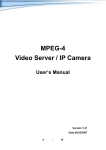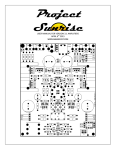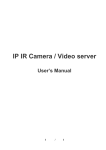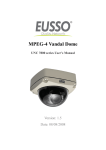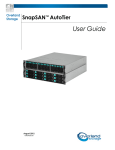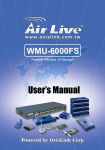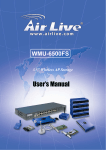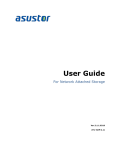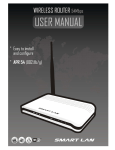Download MPEG-4 VIDEO SERVER User`s Manual 15-CD01NB - E
Transcript
MPEG-4 VIDEO SERVER User’s Manual 15-CD01NB Version:1.31 Date:05/25/2007 0 / 55 Catalog 1. Introduction ................................................................................................................3 1.1. What is the MPEG-4 Video Server?................................................................ 3 1.2. Advanced Features........................................................................................... 3 2. Physical Characteristics ........................................................................................4 3. Installation ..................................................................................................................5 3.1. Installation Preview ......................................................................................... 5 3.2. Hardware Installation ...................................................................................... 6 3.3. Software Installation........................................................................................ 9 3.4. Network Configuration.................................................................................. 10 4. Getting to Know the 15-CD01NB WEB UI ......................................................15 5. 15-CD01NB Configuration ...................................................................................21 5.1. A/V Settings................................................................................................... 22 – General.................................................................................................... 22 – PTZ Settings ........................................................................................... 27 – External Sources ..................................................................................... 28 – On Screen Display .................................................................................. 30 5.2. Network Settings ........................................................................................... 31 – General.................................................................................................... 31 – DDNS...................................................................................................... 32 5.3. System ........................................................................................................... 34 – System Information ................................................................................ 34 – Time Configuration................................................................................. 35 – User ......................................................................................................... 36 5.4. Event.............................................................................................................. 37 – General.................................................................................................... 37 1 / 55 – Motion Area ............................................................................................ 38 – E-Mail / FTP ......................................................................................... 39 6. Broadband Connections Q&A ...........................................................................41 6.1. Case 1 Using default settings ........................................................................ 44 6.2. Assigning ports manually .............................................................................. 45 6.3. Using 2 or more Public IPs............................................................................ 46 7. Troubleshooting .....................................................................................................47 8. Restore Factory Default .......................................................................................49 9. I/O & COM Port Connectors................................................................................50 10. Specifications .......................................................................................................53 2 / 55 11.. IIn nttrro od du uccttiio on n 1.1. What is the MPEG-4 Video Server? The MPEG-4 Video Server (15-CD01NB) is an Internet-based digital video surveillance device with a built-in Web server. It uses TCP/IP to distribute compressed live video over a Local Area Network (LAN) and/or the Internet through an Ethernet connection. The 15-CD01NB is configured and manipulated using the Web-based User Interface (Web UI) in Microsoft Internet Explorer ™. The 15-CD01NB contains an MPEG-4 image compression chipset capable of delivering streaming, constant or variable bit rate MPEG-4 video over the network in real-time. 1.2. Advanced Features Built-in HTTP Web Server. IP address assignment via IP Installer Software or Web UI. ActiveX control for Microsoft Internet Explorer ™ providing maximum performance. Provide Video conference function. Provide recording functions on remote host or storage devices. Support some models of PTZ control protocols. DDNS support for dynamic IP application. Multi-tiered access control. Control of server operations through CGI based scripts for easy integration. Provide Motion detection, E-Mail / FTP settings and Alert for management. Low power, fan-less device with hardware watchdog support providing a robust system for critical environments. MPEG-4 and MJPEG video compression formats. 30/25 fps @ Full D1 (720 x 480 / 720 x 576) resolution. Video stream supported by many media players including QuickTime ™. 3 / 55 22.. P Ph hyyssiiccaall C Ch haarraacctteerriissttiiccss MPEG-4 Video Server 4 / 55 33.. IIn nssttaallllaattiio onn 3.1. Installation Preview There are 3 mains steps required to perform a successful installation: Hardware installation Software installation Network configuration Hardware installation consists of connecting cables to the 15-CD01NB including network, video, and power cables. Software installation consists of the installation of software that is necessary to properly view the video from the 15-CD01NB or to configure the 15-CD01NB itself. The software includes: IP Installer - A utility for locating devices and configuring network settings on a LAN. Component Installer - installs all ActiveX components used by devices for things such as video display and configuration. Adobe Flash Player - necessary for displaying some components of the Web UI. The following are not necessary, but may be used for added convenience: 16-Channel Recording Software - for displaying and recording up to 16 channels simultaneously. Both MPEG-4 and MJPEG devices are supported. Note: the MPEG-4 device can only display and record up to 4 channels. XVID - A MPEG-4 codec. If no other MPEG-4 codecs (i.e. DivX, 3ivX, ffdshow, etc.) are installed on your computer, the Component installer will install this for you. QuickTime or VLC - though not necessary, this can be used for viewing the MPEG-4 stream without a Web browser. Network configuration consists of modifying the network settings for the 15-CD01NB in order to successfully connect to the device. 5 / 55 3.2. Hardware Installation – Hardware Connection Ensure the 15-CD01NB is powered off. Connect the 15-CD01NB to your network using twisted pair (CAT 5) cable terminated with a standard RJ-45 connector. If it is connected to a hub/switch, use a pass-through cable. If it is connected directly to a PC, use a crossover cable. Connect the video output from the camera using standard 75 ohm (Ω) coaxial cable terminated with a BNC connector. (If connecting to a TV, VCR, etc. switch the corresponding DIP Switch to the off position. After ensuring that the power supply adapter specifications (Input AC 110V or 220V ) match the power source, connect the power supply to the 15-CD01NB. 6 / 55 VIDEO IN – Description of the Connections VIDEO OUT RESET J1: Connector for Power / Sensor / RS-485 AC24V: power input 24V ALM 1~ALM4: sensor input J2 RJ45 COM1~COM4: sensor common PORT RS-485+: to RS-485 + J3 RS-485-: to RS-485 - J8 J4 J2: RS-485 Terminal J1 J8: AC24V Output IN / OUT LET J3: Alarm Output / Input NC / CM / NO: Alarm output ALM1~ALM4 / COM: Alarm Input J4: Alarm Output NC / CM / NO Ethernet Connector Standard 10 /100 Base-T port connects to a CAT5 cable with RJ-45 connector. Please follow the below figure for the connection. 3. Power/Status LED Power status indicator, constant red when power is on. 7 / 55 4. Network LED Network Link (connected): Constant red. Networks have activities: Blink red. Data sent out from server: Blink green. Network disconnected: Constant slow blinking green. 8 / 55 3.3. Software Installation With the exception of the Adobe Flash Player all the software that is necessary for the proper display and use of the 15-CD01NB is available on the included CD or from the Web site. For the following installation procedures it is assumed that all installation media will be taken from the CD. – IP Installer The IP Installer is used to locate and configure network cameras and video servers on the LAN. This utility is useful for conveniently configuring the network settings of the 15-CD01NB, or for finding a device once the network settings have been modified. To install the IP Installer, from the installation CD UI, select IP Installer, then follow the on screen instructions. – Component Installer This will install all ActiveX components used by devices for video display and device configuration. – Adobe Flash Player Please visit the Adobe Web site at http://www.adobe.com to download and install the Flash Player. 9 / 55 3.4. Network Configuration IP Installer is a utility that provides an easier, more efficient way to configure the IP address and network settings of the 15-CD01NB. It even provides a convenient way to set the network settings for multiple devices simultaneously using the batch setting function. Moreover, IP Installer can save the network settings for all devices as a backup and restore them when necessary. – Preparation before IP Assignment Always consult your network administrator before assigning an IP address to your server in order to avoid using a previously assigned IP address Ensure the 15-CD01NB is powered on and correctly connected to the network MAC Address: Each 15-CD01NB has a unique Ethernet address (MAC address) shown on the bottom of the 15-CD01NB as the serial number (S/N) with 12 digits (e.g. 000429-XXXXXX). One final note, although the IP Installer is able to find and configure any 15-CD01NB on the LAN (except those that are behind a router), it is a good idea to set the host PC to the same subnet. In order to connect to the Web UI of the 15-CD01NB the host PC must be in the same subnet. For more information about subnets, please consult your network administrator. – Starting IP Installer Once IP Installer has been successfully installed on the computer, double click the IP Installer icon on the desktop, or select it from Start > Programs > IP Installer. 10 / 55 The IP Installer window is displayed below. Click Tool > Search Network Device, the available devices will be listed as below. Using IP Installer 1. From the list, select the device with the MAC Address that corresponds to the device that is to be configured. The MAC Address is identical to the unit’s S/N (Serial Number). 2. Double click the item to open the Property Page dialog box for the selected device or click the menu bar View > Property. 11 / 55 3. After filling in the properties, click [Synchronize] button to complete the configuration settings and save in the network camera and PC immediately. 4. If click [OK] button, the configuration is only be saved in the PC. Opening the Web UI To access the Web UI of the selected unit, right-click on an item in the list and select Open Web, or click View > Open Web on the menu bar. If the device has been configured correctly, the default Web browser will open to the 15-CD01NB home page of the selected device. 12 / 55 If the QuickTime Player has been properly installed, and the video input has been properly connected, then the 15-CD01NB Web UI will display a live video stream. The 15-CD01NB supports video display using either QuickTime (default) or ActiveX. The ActiveX control is only supported in Microsoft Internet Explorer for Windows operating systems. 13 / 55 If the device has been configured to display the video using the ActiveX control, when the Web UI opens for the first time through Internet Explorer, the Internet Security settings must be lowered to perform a one-time-only installation of the ActiveX component. – The procedure of the ActiveX is as follows Before connecting to the 15-CD01NB Web UI, from the Tools menu, select Internet Options. Click the Security tab and take note of your current security settings. Set the security level to Low and click OK. Type the URL or IP address of the 15-CD01NB into the Address field. A dialog box will pop up asking if the ActiveX control should be installed. Click “Yes” to start the installation. Once the ActiveX installation is complete, return the security settings to their original value, as noted above. 14 / 55 44.. G Geettttiin ng g tto oK Kn no ow w tth hee 1155--C CD D0011N NB BW WE EB BU UII The 15-CD01NB Web UI is basically divided into display and configuration. The home page is the video display page which can be seen below. – Main Menu Menu Language Selection Click a language name to change the language display for the complete Web UI. There are three kinds of languages can be selected, they are English, Traditional Chinese and Simplified Chinese. Video Channel Displays either a single video source (from 1 to 4), or all 4 channels Select “Actual” to display the video stream at the real resolution Select “All” to display the local video stream as well as 3 external video sources. It is only available for the video server. 15 / 55 Video Status Display the status for the selected channel on the tab: Video IP, RTSP Port, Resolution, PTZ, Video Type (Mpeg4 or Mjpeg) and Audio. Audio ☆ Audio ON Voice is currently ON; select which channel should be the one for broadcasting the audio. ☆ Audio OFF Voice is currently OFF, click on the icon to turn off the voice feature. Record Button Start Recording / Stop Recording Click on the “Record” button to start or stop recording. Note: This option saves a video streaming into the local computer as an AVI file, and it will be named under Locals_Rec_-YYYYMMDD-HHMMSS.avi. For “YYYYMMDD” stand for year, month and date respectively For “HHMMSS” stand for hour, minutes, seconds respectively. The path to save the recorded files is listed under Recording Setting. The device will create the folder automatically. Rotation Button Turn the image for 90, 180 and 270 degrees. It’s clockwise direction. Configuration Click Configuration to open the configuration pages. This part of detailed contents will be introduced in the “Ch5 15-CD01NB Configuration”. 16 / 55 Video Conference Click “Configuration” to open the configuration pages. Location Define the settings for the local device. Remote Define the settings for the remote device, either IP Camera or Video Server. 17 / 55 Record Setting Video Conference ☆ Reserve Space: Set the total file space for the recording. The unit is in MB. ☆ Max File Length: Set the file space that a single will be using. The unit is in MB. ☆ Save File Path: Indicate which folder should be the file saved to. ☆ Local File Name: Input the name for the local file. ☆ Remote File Name: Input the name for the remote file. ☆ Cycle Recording: This feature indicates if the old space should be used or not for the recording. Make a checkmark in order to enable this function. If you enable this feature, old files will be deleted. ☆ Sync to TimeStamp: This feature enables the file to be saved according to the time. When the video file is displayed, the video will make a match between the frames and the time. 18 / 55 Record Setting Video Conference ☆ IP Address: Enter a valid IP address from a remote IP Camera or Video Server. ☆ HTTP Port: Enter the port number used for the remote IP address to display the video. ☆ User Name / Password: Enter the respective Username and Password if applicable. If no user has been set for the device, the default value should be “root” and “pass” respectively. ☆ Video Channel 1~4: Video channels from 2 to 4 are applicable for Video Servers ☆ Video Type: Select from MJPEG or MPEG4 Video Servers or IP Cameras. Please refer to the original document of the device for a better description. ☆ Rotation: Rotation degrees run from 0 to 270 degrees for a permanent digital position. ☆ RTSP Port: Enter a RTSP Port used for streaming in case the external source is an MPEG4 device. 19 / 55 ☆ Name: Enter a name for the remote device. ☆ PTZ Model: Support some kinds of PTZ models to control remote devices. Note: If your PTZ devices don’t support these models on the menu list, please contact with your distributor. ☆ Product Type: Select from MJPEG or MPEG4 Video Servers or IP Cameras. Please refer to the original document of the device for a better description. Recording Setting Click Recording Setting to open the configuration pages. Location of Recorded Files: Indicates the folder path in which the files will be recorded. Local Source file name: Enter a name for the recorded video External Source File Name: Enter a different name from the local source file name. Full Screen Maximizes to view the selected channels into full screen 20 / 55 55.. 1155--C CD D0011N NB BC Co on nffiig gu urraattiio on n The 15-CD01NB Configuration is currently divided into 4 sections, “Live” and “Reboot”: – A/V Settings Set A/V settings and they include “General”, “PTZ Setting”, “External Source” and “On Screen Display”. – Network Settings Set the network settings and they include “General”, ” and ”DDNS”. – System Set the system settings and they include “System Information”, “Time Configuration” and “Users”. – Event Set the event setting and they include “General”, “Motion Area” and “E-Mail / FTP”. – – “Live” : Returns to the Live Video display. “Reboot”:: Closes the Web browser window and reboots the device. 21 / 55 5.1. A/V Settings – General Basic: Audio Enables and Disables the Audio stream. Resolution There are 3 different resolutions to choose from: ☆ D1: 720x480 NTSC/720x576 PAL ☆ SIF: 352x240 NTSC/352x288 PAL ☆ QSIF: 176x112 NTSC/176x144 PAL Frame Rate The frame rate can be set between 1-30fps. Encoder Format Format can be selected for MPEG4 or MJPEG. Bitrate There are 12 different constant bitrates to choose from between 64Kbps and 4Mbps, and 4 variable bitrates between Low and High quality. 22 / 55 If you are planning on using the device on an Internet connection It is recommended that you select a constant bitrate that corresponds to your actual upload speed. It is also recommended that you modify the frame rate and resolution as well, otherwise the video stream may become blocky or otherwise distorted. The recommended values are as follows: 64Kbps: <=10 fps QSIF 128Kbps: <=15 fps QSIF 256Kbps: <=10 fps SIF 512Kbps: <=15 fps SIF 768Kbps: <=10 fps D1 1Mbps: <=15 fps D1 1.5Mbps: Broadband-cable, T1, Frame-Relay 2Mbps: Cable, T1, Frame-Relay, 10Mbit 2.5Mbps: Cable, T1, Frame-Relay, 10Mbit 3Mbps: Cable, T1, Frame-Relay, 10Mbit 3.5Mbps: Cable, T1, Frame-Relay, 10Mbit 4Mbps: 10/100Mbit For higher frame rate use a variable bitrate instead. However, this is not recommended for Internet use. For Good Quality, full resolution (D1), and full frame rate (30/25 fps) it is recommended that not more than 4 users connect simultaneously. For High Quality, full resolution (D1), and full frame rate (30/25 fps) it is recommended that not more than 2 users connect simultaneously. Auto adjust the frame rate under high-traffic icon: After enable this option, the frame rate will be automatic adjusted to improve the video quality when the network is heavy-loaded. Note: Turn off audio will improve the video quality. Apply Saves the changes made. 23 / 55 Advanced: Interlacing There are two modes available: Interlaced or Progressive. Interlaced mode is a storage mode. An interlaced video stream contains fields rather than frames, with each field containing half of the lines of a frame. A progressive video stream consists of only full frames. Interlaced video streams can bring a lower bitrate but may cause lower quality. TV Standard This is the manual setting; users have to select the TV standard mode of NTSC or PAL. Note: If you do the factory default procedure, the TV standard setting will go back to NTSC mode. Sequence Mode There are 2 different modes available: I-frames only or I-frames and P-frames. P-frames, or predictive frames, are predicted based on prior P or I-frames plus some additional data. They have a much higher compression ratio than I-frames. ☆ I-frame only mode has very little compression resulting in large file sizes. ☆ I-frame and P-frame mode offers relatively good compression with medium file sizes. Although this requires more work on the host PC to decode the video. 24 / 55 GOP Size GOP stands for Group of Pictures. It defines the number of frames from one I-frame to the next. Since an I-frame uses very little compression, while P/B frames use much higher compression, a larger GOP size, results in smaller file sizes. For more information about I/P/B-frames, see below. For MPEG-4 there is no maximum GOP size defined. It can be as low as 1 V just an I-frame - or into the thousands. However, as the GOP size increases, the compression increases, and therefore the more likelihood of errors. A higher GOP size also results in higher buffering times. For DVDs the GOP size is 15. The default on the 15-CD01NB is set to 60, which offers fair compression with a low likelihood of errors. Peak Bitrate This is used to set a maximum bitrate that can be achieved. This is useful for setting bitrates between the values that are available from the Video Encoder bitrate list. Apply Saves the changes made. 25 / 55 Image Adjustment: Contrast, Brightness, Hue and Saturation can be adjusted. Values run from -100 through 100. Rotation Select the Digital Rotation for the camera: 0 – 0 or 360 Degrees; 1- 90 Degrees; 2- 180 Degrees; 3- 270 Degrees. Save Save the update settings. Load Default Set the image adjustments back to factory default. Note for MPEG-4 IP camera: When using Lens with DC-Driver Auto IRIS capabilities in low light conditions, you should disable AES to get optimal lens performance. In strong light conditions it should be enabled to prevent color loss. 26 / 55 – PTZ Settings PTZ Model: Support some kinds of PTZ models to control remote devices. Note: If your PTZ devices don’t support these models on the menu list, please contact with your distributor. Camera ID: Define camera ID to connect video servers when using multi PTZ devices. Serial Mode: Select the serial mode to RS232 or RS485. COM port: This the read-only information and it will auto detect the COM port. Serial databits, Serial baud rate, Serial stopbits and Serial Parity: Every PTZ device has independent PTZ control protocol; please refer the PTZ product manual to check these settings. 27 / 55 – External Sources The “External Sources” feature allows user to set additional network cameras for the device. Video select: 15-CD01NB support four sources to do video control and monitor; the first one is internal source for analog camera connection, so the “Video select” is from 2 to 4. IP Address: Enter a valid IP address from an IP Camera or Video Server. Video Channel: Assign the number of the video channel to identify the video source when use multi channels management software. HTTP Port: Enter the port number used for the IP address to display the video. User Name & Password: Enter the user name and password of the device, if no user has been set for the device, the default value should be “root” and “pass” respectively. Video Type: Select the MJPEG or MPEG4 mode. Rotation: Rotation degrees run from 0 to 270 degrees for a permanent digital position. 28 / 55 PTZ Model: Select the PTZ model if it is an IP speed dome. Name: Enter the name for the device. RTSP Port: Enter the port for the streaming. Product Type: Select the product type. 29 / 55 – On Screen Display Display a text on top of the video 1. Select “0: Disable” or “1: Enable” on screen display item. 2. Enter into the OSD text that should be displayed. 3. Select Coordinates X, Y for the location of the text. 4. Enter the Display Font Gray Levels. 30 / 55 5.2. Network Settings – General Please select the appropriate option to connect. MAC Address: It’s read-only to displays the MAC address of the device. IP Address: Enter the IP address of the device. Subnet Mask: The subnet mask for the network segment to which the device is connected. Device Name: Input a name for the device. Gateway Address: The gateway IP address for the network segment to which the device is connected. DNS Address 1~3: Enter the DNS server IP address used for resolving domain names to IP addresses and others are optional when necessary. IP Setting Mode: ☆ Static IP: Manually assigned IP address. ☆ DHCP: Automatically get IP address from DHCP server. HTTP Port: The port on which the device will receive HTTP requests. RTSP Port: The port on which the device will receive RTSP (streaming video) requests. Static. Apply: Saves the changes made. 31 / 55 – DDNS The DDNS (Dynamic Domain Name Service) is used when users want to access 15-CD01NB with an easy memorized name such as “http://test.dyndns.org” instead of IP Address”. This service could be useful when 15-CD01NB is located behind Dial-up ADSL or IP sharing devices, which does not have fix IP address, then it's impossible to reach 15-CD01NB from Internet. DDNS Settings: System provides two different kinds of settings for DDNS function and users can use both at same time. DDNS Settings 1: This is a public DDNS server that it provides DDNS service without registering any information. ☆ DDNS Settings 1: “Enable” or “Disable” the DDNS function. ☆ Device Name: Enter the name of the device. I.E: If the device name is “test” and the accessed DDNS server name is “dyndns.org”. This device DDNS name is “test.dyndns.org”. ☆ DDNS Server Address: Enter the DDNS server address or domain name. ☆ DDNS Connect Port: Specify DDNS server listen port, and the default is "80". ☆ Router Incoming Port: Specify your router listen port for DDNS server to redirect. The router may configure the different port for incoming (Internet request) and outgoing (Intranet request), e.g. it may configure to redirect 32 / 55 Internet HTTP (port 80) request to Intranet port 8000, then, in this case, we must configure the "Router Incoming Port" to 80, and inside the 15-CD01NB Network settings should set HTTP port with 8000. ☆ Update Time: Specify the 15-CD01NB updated frequency in seconds, and the default is 600 (10 minutes), this is interval that 15-CD01NB will automatically send an updated packet to DDNS server. ☆ Apply: Saves the changes made. DDNS Settings 2: This is not a full public DDNS server that it provides DDNS service and must register some information in the server. ☆ DDNS Settings 2: “Enable” or “Disable” the DDNS function. ☆ DDNS Host Name: Specific the DDNS server host name. ☆ Account ID: Specify your account ID that you registered in the DDNS server. ☆ Password: Specify your password that you registered in the DDNS server. ☆ Apply: Saves the changes made. DDNS Message: Return messages from remote DDNS server, and some hints may help to diagnostic the reason if register fails.. ☆ DDNSaddr CGI Fail: It means that 15-CD01NB can't communicate with Internet world. Make sure your Network Configuration has correct subnet mask and default gateway, and DNS1 setting is correct and reachable. 33 / 55 ☆ Already Registered: Another user had registered this name; please change your register name by changing server name. 5.3. System – System Information MAC Address: This is the read-only information to Display the device's MAC address. Language: Select the language to be used. English, Traditional and Simplified Chinese can be chosen. Description: Useful as an administrative identifier. It does not affect the operation of the device. Location: Useful for identifying the position of the device. It does not affect the operation of the device. Model: Displays the model number for the device. Firmware Version: Displays the firmware version to easily compare firmware version when user upgrade firmware. Apply: Saves the changes made. Load Default: If select this button, system would be reset to factory default, but not include ”Network Settings”. 34 / 55 – Time Configuration Server Time Setting: The 15-CD01NB provide two kinds of time settings. Server Time: This is read-only information to display 15-CD01NB system time. Time Mode: ☆ Synchronize with NTP server: Auto synchronizes the time with NTP server by the time zone and the NTP server 1~3 settings. ☆ Set Manually: Manually enter the system date and time or synchronize with computer time. Apply: Saves the changes made. 35 / 55 – User Note: The first added user must have administrative right, and must be the last one to be removed. To add a user, first enter the user name and password in the respective fields, and then click on “Add User”. To remove a user, first select the user from the list, and then click “Delete User”. User Name: The user name must be between 1 and 16 characters and cannot include the following characters: , : & Password: The password must be between 1 and 16 characters and cannot include the following characters: , : & Channel 1~4 Permission Settings: To set up the permissions for the general users which channels could be accessed. These settings must have administrator permissions. 36 / 55 5.4. Event – General Trigger: System provides “GPIN” and “Motion Detection” to trigger events. GPIN & GPIO Input Status: They are auto detected to display the status. Motion Detection: When Users would like to use “Motion Area” function and this icon must be enabled. Action: Use some functions to record events. FTP Image: When Users would like to use “FTP Setting” function and this icon must be enabled. Mail Image: When Users would like to use “E-Mail Setting” function and this icon must be enabled. GPOUT: It is auto detected to display the status. Relay Out: Turn “Off” or “ON” for relay out setting. Alert Message Status: They are auto detected to display the status with the recording application software. Apply: Saves the changes made. 37 / 55 – Motion Area Motion Area: The “Motion Detection” icon (Configuration>Event>General>Trigger) must be enabled when use this function. Use Mouse to drag out a detection area on the video. Left-click the area and drag the corner to change the size. Right-click the area and select “Property”. Check “Enable”, click “OK” and click “Apply”. Note: Green blocks indicate this area is enabled for detection. Red blocks indicate this area is not enabled for detection. 38 / 55 Box Property: Motion vector threshold (default value: 4000): Motion vectors are typically used to compress video by storing the changes to an image from one frame to the next. We use these vectors creatively to detect and track motion and to find an alternative to traditional video decoding using phase shifting. SAD (Sum of Absolute Differences) threshold (default value:50): SAD number value that the difference of movements of the image drew, will be started and made video recording when there are differences in SAD number value before and after comparing. Sensitivity (default value:60): This number value is the sensitivity of setting up Motion Detect Recording; the higher number value will start Motion Detect Recording function. 39 / 55 – E-Mail / FTP E-mail Setting: The “E-Mail Image” icon (Configuration>Event>General>Active) must be enabled when use this function. Mail From: Enter the mail address of the mail sender. Receipt To: Enter the mail address of the mail receiver. Mail Server: Enter the mail server name or IP address. Authorization: Disable or enable the security for mail authorization. Account ID & Password: Enter the user name and password for the mail sender. FTP Setting: The “FTP Image” icon (Configuration>Event>General>Active) must be enabled when use this function. Host Name: Enter the IP address of the FTP server. User Name & Password: Enter the user name and password for the FTP server. Apply: Saves the changes made. 40 / 55 66.. B Brro oaad db baan nd dC Co on nn neeccttiio on nss Q Q& &A A – How can I configure my Video Server with my ADSL connection? When using an ADSL connection you have to know if your ISP assigned you a Static Public IP or Dynamic Public IP. Consult with your ISP for more information. – What is the difference between Static Public IP and Dynamic Public IP? When using a Static Public IP, every time you get connected to the ISP, you will be using the same IP; when using a Dynamic Public IP, every time you get connected to your ISP, you will be using a different IP. – Can I plug my Video Server directly into the ADSL Modem? No, the main reason is that presently, the Video Server doesn’t have the PPPoE feature, even if you plugged it in, there must be a feature present that dials to the ISP. – I only have an ADSL connection and don’t plan on getting a static Public IP. What can I do in order to make this work? You can buy a Router which needs to have PPPoE and port forwarding capabilities. In the market, mostly all routers come with these features and they aren’t expensive. Please consult with your provider regarding this matter. Refer to the next section for Port Forwarding settings. 41 / 55 – Once I set this up, how can I view my camera through a remote location? You can register your camera or video server at our DDNS Service, and even if your Public IP changes, you can access it from a remote location. Refer to Video Server Manual at Network Configurations, DDNS settings in order to set it up. – How can I view my camera from a remote location through Internet when running the camera through my Local Network? This will require some configuration on your broadband router. – Useful terms: Broadband Router: A broadband router allows users to share a single Internet connection. TCP/IP: TCP/IP is the protocol that computers use to communicate on the Internet. TCP/IP Ports: Each service you use on the Internet communicates using one or more specific port numbers; your e-mail program uses port number 25 to send e-mail, and port 110 to receive e-mail from your e-mail server. When you browse the Internet, port number 80 is used as default to send and receive Web pages. IP Address: Everything that is connected to a TCP/IP network needs a unique address, an IP address. This is what happens when you browse the Internet with requests to view Web pages. Public IP Address: A Public IP Address is the only IP address that is recognized on the Internet, where the term Internet refers to the global network, the World Wide Web. Local IP Address: A local IP address can only be used internally, on a local network. A computer with a local IP address cannot access the Internet itself. It can however, access the Internet via another computing device, e.g. a broadband router. Port Forwarding : Port forwarding, is essentially a method for a broadband router to forward data traffic aimed for one port on its public network interface to a computer or network camera on the local network. Ports run from 0 to 65535. Note that ports 42 / 55 0 to 1024 are well known ports, which means that those ports are already assigned to specific services. So when you consider choosing your own ports, select those starting from 1025 to 65535. – Configuration Examples: You are a user with a network camera who wants to access it from a remote location through the Internet. The following equipment is available: E 1 Network Camera Sever. E 1 PC running Windows. E 1 Broadband Router. We need to direct all incoming requests that reach port 80 the public network interface of the broadband router, so that these are forwarded to the cameras IP address on the local network. Consult your broadband routers manual for information on how to configure port forwarding. Depending on the router, it could be denominated as Port Forwarding/NAT/Virtual Server. Usually it will look like this: Private IP Private Port 43 Type / 55 Public Port 6.1. Case 1 Using default settings In this case what we have here is: 1 Public IP Address 210.20.35.163, assigned by the Internet Service Provider (ISP). 1 Camera Server, with a local IP of 192.168.1.21. 1 Broadband router. Since we are sharing only one single Internet connection through our Local Network, the Port Forwarding configuration in our Broadband Router for the camera will be as follows: Private IP Private Port 192.168.1.21 80 Type Public Port 80 Notice that the Port 80 is the default port for any Web-Server, but this also can be changed. Since Port 80 is the default, when we type our IP address at the Address bar, there won’t be any need to type the port number. Once the broadband routers configurations are set, we can open the Internet Explorer and type in the Address bar the Public IP address. Can I use DHCP from my router to assign an IP to my camera? We don’t suggest it, if you do this, every time you reboot your camera, a new IP will be assigned and you will have to configure again your router in your Port Forwarding configuration. 44 / 55 6.2. Assigning ports manually In this case what we have here is: 1 Public IP Address 210.20.35.163, assigned by the Internet Service Provider (ISP), but we will be using Port 9999 for accessing the camera from the Internet. 1 Video Server, with a local IP of 192.168.1.21, using port 9999 to get access to the camera through the Local Network 1 Broadband router Since we are sharing only one single Internet connection through our Local Network, the Port Forwarding configuration in our Broadband Router for the camera will be as follows: Private IP 192.168.1.21 Private Port Type Public Port 9999 9999 In this case we are using Port 9999 for the camera server at 192.168.1.21, and using Port 9999 for the Internet access at 210.20.35.163. When we are in a remote location, in order to access our camera through Internet, we have to specify the Public Port when typing the Public IP Address as the figure below: Note that if changes are made to the port assignation, some configurations at the 15-CD01NB also have to be changed, such as Network and DDNS settings. 45 / 55 6.3. Using 2 or more Public IPs The following figure is just an illustration on how the camera can be connected when 2 or more Public IPs are involved in a network infrastructure. In this case, the network configurations for the camera such as IP address, Gateway, DNS will be assigned by the ISP. 46 / 55 77.. T Trro ou ub blleessh ho oo ottiin ng g Symptom: The 15-CD01NB can not be accessed from a Web Browser. Possible Causes Remedial Actions The IP address is already used by another device. Disconnect your 15-CD01NB from the network. Run the PING utility and follow the appropriate recommendations. Note: The assigned IP number can be assumed valid if the PING utility returns "request timed out" - in which case you should set the IP address again, power on the 15-CD01NB and then try accessing the unit again. The IP address is located within a different subnet. Run the PING utility, If the utility returns "no response" or similar, the diagnosis is probably correct. Then, you should proceed as follows: In Windows 95/98 or Windows NT, check that the IP address for your 15-CD01NB is within the same subnet as your workstation: Click "Start", "Settings", "Control Panel" and "Network". Specify the TCP/IP adapter and click on Properties. Then, click "IP Address" in Properties. Check that the first 3 numbers within the IP address of your 15-CD01NB matches the first 3 ones of your workstation. If not, your 15-CD01NB may be on a different subnet and the IP address cannot be set from this workstation. You must set the IP address for the 15-CD01NB from a workstation on the same subnet. 47 / 55 In Windows 95/98, the ARP table was empty when you tried to set the IP address. In Windows 95/98, the ARP command can't be used if your have an empty ARP table. Type arp Va to view the ARP table. If it is empty, you must ping an existing unit on your network before you can download the IP address to the 15-CD01NB. A programming script locks the unit. Restore the unit to the factory default settings. 48 / 55 88.. R Reesstto orree F Faacctto orryy D Deeffaau ulltt To restore the factory default for 15-CD01NB, please follow the steps: 1. Plug out the power jack to turn off the 15-CD01NB. 2. Notice at the Power LED, when power on the LED is red, wait for few seconds, the LED becomes to orange, wait for the orange LED flash four times, it will back to red, at the moment, release the button in the hole and the 15-CD01NB will be restored to factory defaults. 49 / 55 99.. II//O O& &C CO OM MP Po orrtt C Co on nn neecctto orrss The GPIO & COM provides control signal input and output, which including one GPIO input, GPIO output as Relay connection and one RS-485 port multiplex with COM port. The GPIO & COM port provide connection of PTZ devices and external console to control the device. – See following picture indicate the Pin direction: COM / GPIO MINI-DIN PIN NAME 1 GPIN 2 RXD (Receive Data) 3 TXD (Transmit Data) 4 RS-485A 5 GND (System Ground) 6 GPOUT-Automatic Relay 7 GPOUT-Automatic Relay 8 RS-485B 9 Video Out 50 / 55 GPIN: Input high when opening the connection; input low when sinking more than 10mA or shorting to pin 5 (GND). RXD (COM Port Receive Data) TXD (COM Port Transmit Data) RS485A / RS485B: To connect with external PTZ devices, please contact your dealer/distributor to get the information of the supported PTZ models. GND (System Ground): System Ground is also connected to chassis as frame ground. GPOUT-Automatic Relay: When enable to use the GPIN or motion detection to trigger some alarm devices, the “Relay Out” must be turned on. Video Out: Use the especial cable in the product package to connect this pin that it can output the video to the monitor. 51 / 55 – Specifications of the Solid state Relay: Features: Normally Open, Single Pole Single Throw Control 350VAC or DC Voltage Switch 130mA Loads LED control Current, 5mA Low ON-Resistance dv/dt, >500 V/ms IsolationTest Voltage, 3750VACrms Ω Absolute Maximum Ratings: (TA=25℃) Emitter (Input) Detector (Output) Reverse Voltage: 5.0V Output Breakdown Voltage: ±350V Continuous Forward Current: 50mA Continuous Load Current: ±130mA Peak Forward Current: 1A Power Dissipation: 500mW Power Dissipation: 100mW Derate Linearly from 25℃: 1.3mW/℃ General Characteristics Isolation Test Voltage: 3750VACrms Storage Temperature Range: -40℃ to +125℃ Isolation Resistance: Operating Temperature Range: Vio=500V, TA=25℃, ≧1010Ω -30℃ to +85℃ Junction Temperature: 100℃ Soldering Temperature, Total Power Dissipation: 550mW Derate Linearly from 25℃: 2.5mW/℃ 2mm from case,10 sec: 260℃ 52 / 55 1100.. S Sp peecciiffiiccaattiio on nss Hardware System CPU: 32-Bit RISC Processor ROM: 4MB Flash ROM RAM 32MB SDRAM Watchdog: Chip to monitor system voltage tolerance and abnormal program execution Connectors One RJ-45 connector for Ethernet One mini-DIN for RS-485/RS-232/GPIO/Video out -- RS-485: for external Pan/Tilt (PT) device control -- RS-232: for console connection -- GPIO: for one fully opto-isolated alarm input -- Video out: for connecting to CCTV monitors, DVR, etc. One BNC video input, and one BNC loopback video output Two LEDs to indicate network and power/system status Network Network Interface 10/100 Base-T Ethernet Resolutions Full D1 (4SIF): NTSC = 720x480; PAL = 720x576 SIF: NTSC = 352x240; PAL = 352x288 QSIF: NTSC = 176x112; PAL = 176x144 Video Bitrate 16K ~ 4M bits/sec (CBR/VBR configurable (high quality VBR settings for MJPEG can reach up to 10Mbps) 53 / 55 Management Installation IP Installer (Win32 Application) Client PC Requirements Pentium 4 2.0GHz or equivalent 512MB RAM Microsoft Windows 98se/Me/2000/XP Microsoft Internet Explorer 5.x or above Microsoft DirectX 9.0c Macromedia Flash 6 Xvid MPEG-4 Codec Security Multi-tiered access control for configuration Recording Directly from Web UI while viewing the live video stream Ware Recording Software – free 16-channel surveillance and configuration software Operating Environment Operating Temperature 5°C ~50°C (40°F ~ 125°F) Operating Humidity 20%~80% RHG Power Consumption < 8 watts (Fuse: 250V / 2A) Mechanical Design Dimension 239(L) X 179(W) X 55(H) mm Net Weight 1.44 KGS (excluding power adapter) Approvals CE/ FCC 54 / 55























































